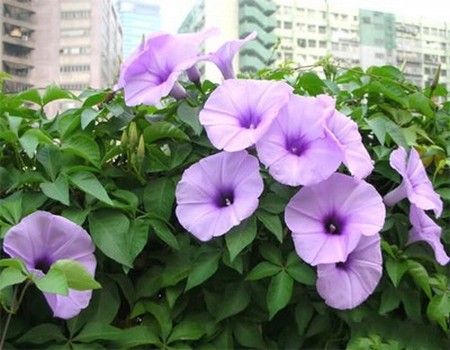The breeding method of Golden Dragon with five claws
The five-clawed golden dragon (scientific name: Ipomoea cairica) is a perennial herb of the order Cyanoptera, Spirulaceae and sweet potato, commonly known as Pandora paniculata and Petunia paniculata. It usually grows in the mountains. The leaves are palmlike, with 5-7 fissures, about 3-10 cm in size; the flowers are funnel-shaped, about 4-6 cm in size, with 5 stamens, and the florescence is at its peak in summer. Native to tropical Africa and Asia, growing in all-day sunshine and good drainage environment, flat land, mountain roadside thickets, sunny places, has a strong climbing ability. The whole plant or root has medical effect, can cool blood, strengthen muscles and bones, and mainly treat injury, fracture, rheumatism and amenorrhea.

Golden dragon with five claws, like sunny, warm and humid climate, loose and fertile soil. Most of them are born in sunny places at low elevations and grow in walls, eaves, flat land or mountain roadside thickets. Sowing or cutting propagation is the most suitable for sowing in May, and it can sprout in 5 days and 6 days after covering with soil. The seedlings can be divided when the double leaves are unfolded.
To sow and reproduce:
Before sowing, we should first select the seeds. Whether the seeds are good or not is directly related to the success of sowing. It is best to choose the seeds harvested in the same year. The longer the seed is preserved, the lower the germination rate is. Choose seeds with full grains, no defects or deformities, and no diseases and insect pests. Families usually soak the seeds in hot water for about 60 ℃ for a quarter of an hour, and then use warm hot water to accelerate germination for 12 to 24 hours. The best way to disinfect the substrate used for sowing is to stir-fry it in a pan so that any diseases and insects can be scalded to death. Soak the seeds in warm hot water (the temperature is about the same as facial wash) for 12 to 24 hours until the seeds absorb water and expand. For common seeds that germinate easily, this work does not have to be done.
For tiny seeds that are difficult to pick up with hands or other tools, wet one end of the toothpick with water, stick the seeds one by one on the surface of the matrix, cover the matrix 1 cm thick, and then put the seeding flowerpot into the water. the depth of the water is 1 inch 2pm 3 of the height of the flowerpot, allowing the water to soak up slowly (this method is called "pot immersion").
For larger seeds that can be picked up by hand or other tools, put the seeds directly into the substrate and order them at a distance of 3 × 5 cm. After sowing, the substrate was covered, and the thickness of the cover was 2-3 times that of the seed. After sowing, you can use sprayers and fine-hole showers to wet the sowing matrix, and later, when the basin soil is slightly dry, you should still pay attention to the watering strength not to wash the seeds up.
Cutting propagation:
It is often used for softwood cutting in late spring and early autumn, or old wood cuttings with branches from last year in early spring. When the tender wood cuttings were carried out, the sturdy branches of the current year were selected as cuttings when the plants were growing vigorously from the end of spring to early autumn. After cutting off the branches, select the sturdy parts and cut them into segments 5-15 cm long, each with more than 3 leaf nodes. When cutting cuttings, it should be noted that the upper cut is cut flat at about 1 cm above the uppermost leaf node, and the lower cut is about 0.5 cm below the lowest leaf node, and the upper and lower cut should be flat (knife should be sharp). When hardwood cuttings are carried out, after the temperature rises in early spring, last year's robust branches are selected as cuttings. Each cuttage usually retains 3-4 nodes, and the cutting method is the same as that of softwood cuttings.
Time: 2019-06-11 Click:
- Prev

The method of ramet propagation of Cymbidium
Smiling gentleman orchid, when the flower blossoms, it seems to bow its head and smile, so its name. The asexual reproduction of flowers has the methods of cutting, ramet, striping, grafting and so on, but the asexual reproduction of Cymbidium is generally only the method of dividing plants, and this method is more common. To propagate by means of separate plants.
- Next

To master the method of topdressing edible fungi, the key is to prevent green mold of edible fungi.
The key is to prevent green mold from edible fungi.
Related
- Fuxing push coffee new agricultural production and marketing class: lack of small-scale processing plants
- Jujube rice field leisure farm deep ploughing Yilan for five years to create a space for organic food and play
- Nongyu Farm-A trial of organic papaya for brave women with advanced technology
- Four points for attention in the prevention and control of diseases and insect pests of edible fungi
- How to add nutrient solution to Edible Fungi
- Is there any good way to control edible fungus mites?
- Open Inoculation Technology of Edible Fungi
- Is there any clever way to use fertilizer for edible fungus in winter?
- What agents are used to kill the pathogens of edible fungi in the mushroom shed?
- Rapid drying of Edible Fungi

